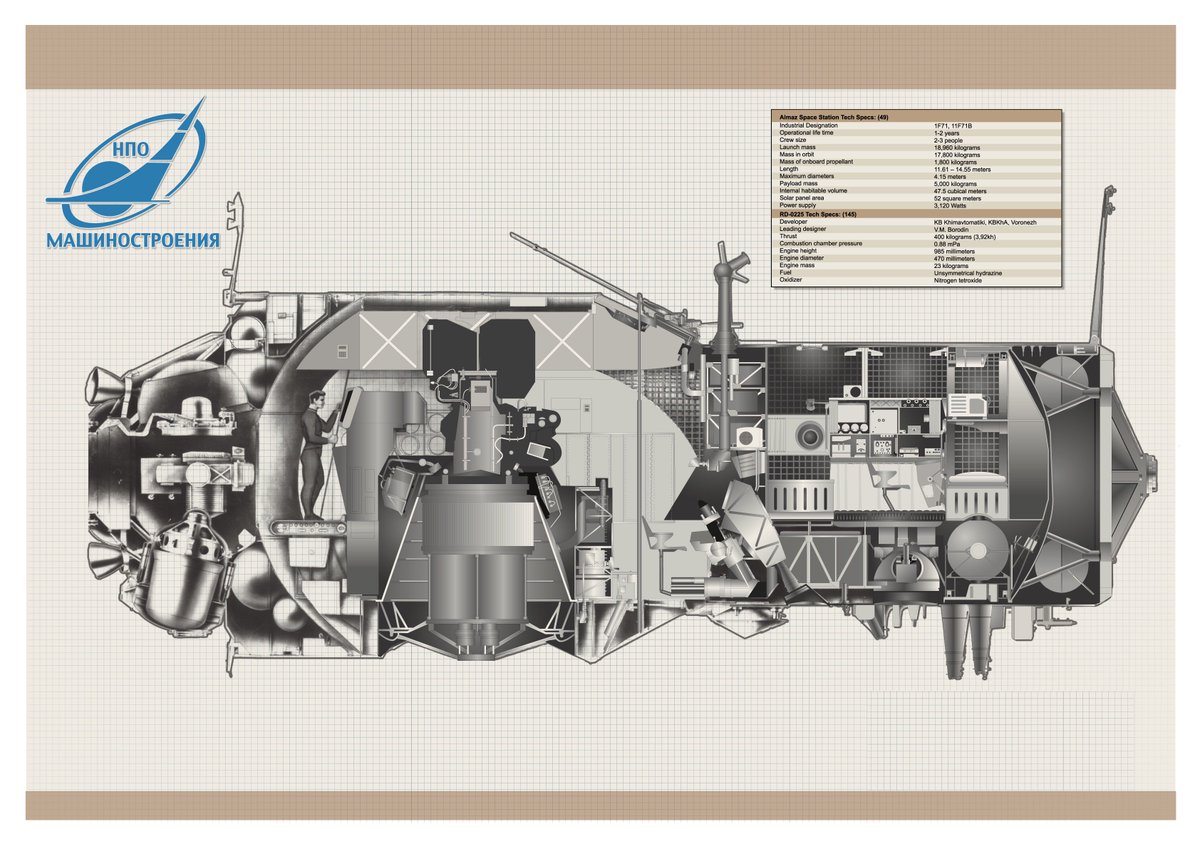Soviet Space Stations: Salyut 5 & The Future of Almaz

Salyut 5 (aka Almaz 3 or OPS-3) (source)
Salyut 5 was launched in mid-1976, while Salyut 4 was still in orbit but abandoned for over a year. It was the last Almaz station that was inhabited and used for its intended purpose of military reconnaissance, but it also provided its fair share of exciting events in the early history of space stations.
Scientific Equipment and Design
The overall layout of OPS-3 was the same as the previous two Almaz stations, but there was no known gun attached like Almaz 2. There was also equipment onboard that permitted a propellant transfer test, in preparation for future space stations.
Scientific equipment included the Agat Earth-observation camera used for both military reconnaissance and civilian work, the Kristall furnace for crystal-growing experiments, an aquarium for observing fish, the Potok flow experiment studying zero-G capillary pumps, and the Sfera metal smelter studying zero-G metal crystal formation. Zero-G soldering was tested with Reaktsia, and proved superior to soldering in gravity, and Diffuziya yielded a similar result with alloying metals (source).
The Mission
Salyut 5 launched in mid-1976, with its first expedition, Soyuz 21, launching two weeks later in a 7K-T Soyuz ferry. Though expected to stay much longer, the crew only stayed six weeks. The reason is unclear - the most prominent theory is that there was a nitric acid leak, possibly stemming from the propellant transfer test. Other theories include poor exercise discipline, emotional weakness, a fire, or that the fumes came from developing film on the station. Either way, they returned early, and one of the cosmonauts was in extremely poor health.
Soyuz 23 launched two months after 21's return, but it's docking system malfunctioned and wasted too much fuel. The crew aborted, and the capsule splashed down in an icy lake, which the crew survived against formidable odds.
Soyuz 24 launched early in 1977, and after docking, performed several tests to ensure the air in the station was survived. It tested clean, but they still entered with breathing masks to be sure. During this mission they also tested refreshing the air by pumping in air from the Soyuz capsule while venting the old air out through the airlock. Their mission only lasted 18 days, mainly because the station was running out of fuel to maintain it's orbit. They returned to Earth, with a sample return capsule following the next day. They too had some difficulty with their recovery on Earth, landing in a heavy blizzard. Salyut 5 deorbited five months later.
OPS-4, The Station That Never Flew

Possible layout of OPS-4 (source)
One more Almaz station was planned, Almaz 4, which would have sported a VA crew capsule, an aft port for TKS spacecraft, synthetic-aperture radars, and a new two-projectile anti-satellite weapon. However, the VA capsule wasn't ready so the front docking port was adapted for Soyuz. Eventually, it was decided that unmanned spy satellites were far more effective than a manned space station was worth, so the remaining Almaz stations were cancelled.

Some other potential designs for future Almaz stations, including a multiport station at far right (source)

Almaz-T
The many surplus Almaz hulls lived on in various ways. Several were outfitted as heavy unmanned radar satellites, called Almaz-T or Almaz 1V. The primary differences were the larger solar panels moved to the forward compartment, and the addition of several antennas, synthetic-aperture radars, and cameras.

An Almaz 1V radar satellite (source)

Another example of the earlier Almaz-T (source)
Only three Almaz-derived satellites were launched.
Excalibur Almaz
Almaz strangely lives on in a modern attempt to launch extant Almaz hulls as a tourist space station, with the VA capsule as a crew ferry. While it was supposed to be very easy to get started, by simply reusing a decade-old system, much of the company's concept art shows wildly different configurations and no progress has been made towards actually getting paying passengers onboard.


Comments
Post a Comment